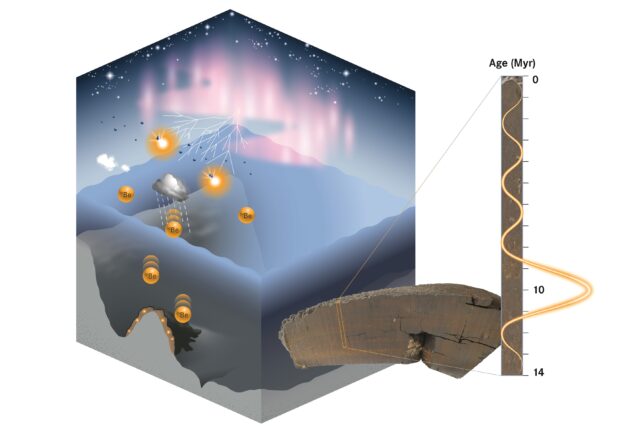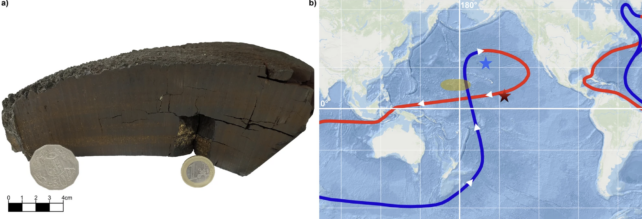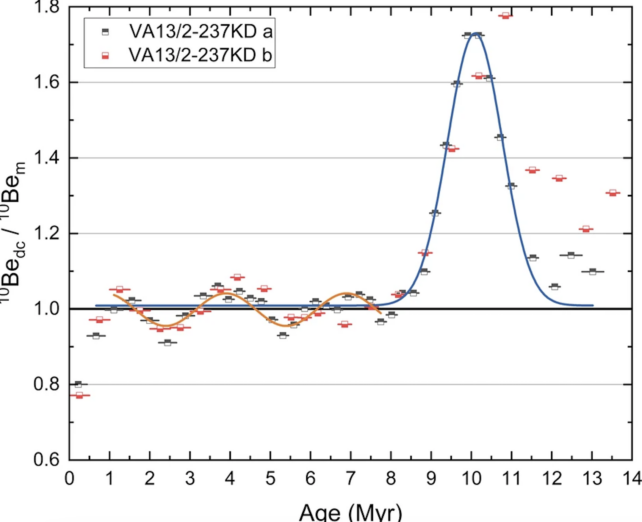
A mysterious radioactive ‘blip’ has been observed deep beneath the Pacific Ocean.
Researchers in Germany, while examining multiple thin layers of seafloor crust, have noted a sudden spike in the radioactive isotope Beryllium-10 that occurred between 9 to 12 million years ago.
This anomaly was detected in the seabeds of the Central and Northern Pacific, but Dominik Koll, the lead physicist from the Helmholtz-Zentrum Dresden-Rossendorf research institute, suggests that this peculiar phenomenon may extend across the entire Pacific and possibly beyond.
The source of this unexpected increase remains unclear, but scientists have proposed several theories.
Beryllium-10 is a radioactive isotope continuously generated by cosmic rays interacting with Earth’s atmosphere. When it falls from the atmosphere and settles into the ocean, it integrates into the slow-growing ferromanganese crusts rich in metals.
Researchers, including Koll and his team, hypothesize that around 9 million years ago, a significant shift in ocean currents might have led to the increased deposition of beryllium-10 in the Pacific.
Alternatively, this event could be a global occurrence. The cosmic aftermath of a nearby supernova or our Solar System’s traversal through a cold interstellar cloud could increase cosmic ray activity, resulting in heightened beryllium-10 levels in the ocean.

Ferromanganese crusts, which accumulate beryllium-10, exist in all Earth’s oceans and can encapsulate millions of years of oceanic chemistry within just a few millimeters.
By analyzing the gradual decay of beryllium-10 into a type of boron, researchers can estimate the age of minerals within Earth’s crust, providing insight into Earth’s geological history.
These ancient crusts serve as near-continuous geological records of our planet over roughly the past 75 million years, but dating them with precision can be challenging. Standard carbon dating techniques are limited to about 50,000 years, while uranium decay methods are not reliable.
Beryllium-10 offers a key to unlock at least 10 million years of this geological archive.
The half-life of beryllium-10 is approximately 1.4 million years, which allows for dating up to about 20 millimeters of ferromanganese crust, with most samples ranging from 1 to 26 centimeters in thickness.

However, what Koll and his team discovered in the Pacific was unexpected.
“At around 10 million years ago, we found nearly double the amount of 10Be than we had anticipated,” Koll stated, emphasizing that they had uncovered an unanticipated anomaly.
This anomaly could serve as a unique chronological marker for marine geological records, akin to a bookmark in a history book.
The team validated their findings across various Pacific locations, with one 50-millimeter section of ferromanganese crust dating back over 18 million years.
They determined the growth rate of the ferromanganese crust in the Pacific to be 1.52 mm per million years, indicating that the depth of the anomaly dates back to between 10.5 and 11.8 million years ago.
The presence of beryllium-10 within these samples effectively indicates their age.

The origins of this anomaly remain uncertain, the authors note, as it is unlikely that activity from our Sun could have produced such a long-lasting spike in beryllium. The research team suspects that Earth’s defense against interstellar cosmic rays may have shifted approximately 10 million years ago.
Alternatively, a nearby supernova may have inundated our planet with an unusually high level of radioactive material.
“Only further measurements can clarify if the beryllium anomaly was induced by shifts in ocean currents or if it has an astrophysical basis,” Koll remarks.
The researchers plan to examine additional samples in the future and hope other teams will explore this intriguing anomaly as well.
Ultimately, time will reveal whether the beryllium blip constitutes a localized or global phenomenon.
The findings were published in Nature Communications.









